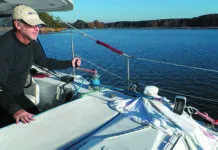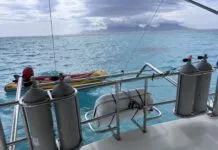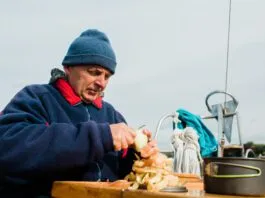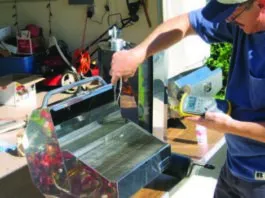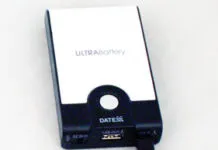New Clear, No-rust Propane Tanks
Unlike aluminum or steel propane tanks, clear composite tanks allow users to see how much fuel remains, a nice feature in an LPG tank.Following our year-long evaluation of Ragasco’s 9-kilogram one-piece blow-molded tank, Practical Sailor tested the American-made Lite Cylinder, a two-piece composite tank. The two tanks have nearly identical dimensions, and may be a challenge to fit in a standard propane locker designed for metal tanks. In fire tests, composite tanks melt rather than “explode” like metal tanks, giving them a slight edge in safety, and the non-metal tanks resist rusting, a common problem of aluminum LPG tanks.
HeatMate Takes the Chill Off
When temperatures decrease, the search for viable heating options by shivering sailors invariably increases. A recent cold winters night provided the perfect opportunity for one blue-nosed liveaboard Practical Sailor tester to check out the HeatMate 5200 heater-stove from Contoure International Inc. The HeatMate 5200 is a portable, non-pressurized alcohol heater that easily converts into a stove. Weighing in at about 5 pounds, the fairly compact, aluminum unit measures approximately 11.75 inches tall by 11.5 inches in diameter, and it comes assembled and ready to go.
The Search is on for the Best Degreaser for Marine Grit and Grime
Practical Sailor searched for the top liquid degreasers to tackle heavy grease on marine stoves and marine engines. Eleven products were tested, including Chomp oil eater, Holy Cow degreaser, Kafko degreaser, Krud Kutter degreaser, Mary Kate Grease Away, Star brite All Purpose Citrus Cleaner Degreaser, and Star brite Sea Safe Cleaner Degreaser. Practical Sailor tested the liquid marine cleaners on grimy fiberglass panels and on aged, greasy farm equipment engines.
Mailport: February 2010
The February 2010 issue of Practical Sailor has letters on the following topics: requests for more used boat reviews, foggy electronics, hard varnishes, propane fridges and Iphone apps.
Cookin with Collapsible Bakeware
Space is always at a premium on a boat, and the galley tends to get very small, very quickly-even with a minimum of pots, pans, and cooking utensils onboard. Practical Sailor reviewed one galley space-saver, nesting cookware, in the April 2009 issue, and more recently tried out FoldTuk Kitchenware. Where nesting cookware is designed for stovetop use, the FoldTuk line can be used to bake, serve, and cold-store a meal, all in the same rattle-proof container, which saves on storage space, water for dishwashing, and power.
Stocking Stuffers For Sailors
Its hard to believe, but the 2009 holiday season is upon us. As is custom, Practical Sailor editors have put together a varied roundup of gifts to stuff those stockings more likely to hang from a bulkhead than the mantle. For the racing or small-boat sailor whos making the leap from wire rope to high-tech fiber, Colligo Marines Softies offer a lightweight alternative to traditional steel shackles and headsail hanks. Made of extra strong and chafe-resistant Dyneema, the "soft" hardware is the perfect solution for use with synthetic forestays, and unlike metal hanks, theyll never leave rust stains on sails. Using the Softies is as easy as pulling the shake-resistant knot through the expandable spliced loop, then sliding the slip ring (rubber O-rings) up to the knot. A lanyard ensures easy opening, but the self-tightening O-rings offer added security against accidental opening or shaking loose.
Navigator Wood Stoves Provide Classic Heating and Cooking Onboard
Navigator Stoves, based on Orcas Island in Washington state, produces three classic wood-burning stoves for use onboard boats and in cabins, RVs, and other small structures. The Little Cod and Sardine stove models are produced using the patterns originally made at the Lunenberg Foundry in Nova Scotia. The Halibut stove model is based on an old favorite, the Shipmate stove. The cast-iron custom-made stoves and can be ordered in the original stove polish or one of six porcelain enamels. They can burn wood and charcoal. The Halibut stove model can also burn coal. For use in warmer months, Navigator has designed denatured-alcohol drop-in burners for cooking.
Practical Sailors Gear of the Year 2009
Practical Sailor editors pored over the dozens of products reviewed in the previous months to find the best of the best sailing gear, products that are worthy of the designation Gear of the Year. This years editors choice list includes a rugged rope clutch (Spinlock), a grippy ratchet block (Ronstan), feature-filled VHF handheld radios (Standard Horizon and Cobra), high-quality nesting cookware (Magma), a proven paste wax (Collinite), an ocean-ready first-aid kit (Adventure Medical Kits), a reliable LED bulb for cabin lighting (Imtra), an economical ice box conversion kit (Frigoboat), an innovative ultrasonic tank sensor (BEP Marine), cold-weather gloves (Gill), and an easy-to-install Wi-Fi booster (5mileWiFi).
Conversion Kits that Turn Your Boat’s Ice Box Into a Galley Refrigerator
Practical Sailor tested three kits that convert onboard ice boxes into full-fledged refrigeration systems. The three reefer conversion kits in the review-the Waeco-Adler Barbour Cold Machine (CU 100) from Dometic Corp., the Frigoboat Capri 35F by Veco SPA, and the Sea Frost BD-represent a cross-section of whats available on todays refrigeration conversion kit market. Testers looked closely at energy efficiency and the 12-volt units abilities to cool a small ice box with the least amount of amp hours possible. Testers looked at quality, details, reliability, and cooling capacity.
Riffin on Foods that Need No Fridge
You might be surprised how well you can eat fresh without a fridge, even in the tropics. Onions and potatoes will keep for weeks (but not together, please). Lemons, limes, and oranges-especially those with thick skins-will survive for weeks. Fresh green tomatoes shrug off lumpy seas and still ripen nicely. Bananas don't like cold to begin with. Hang a green bunch from the backstay, and theyre happy. Be ready, though. They ripen fast . . . banana bread for breakfast! Rice and beans offer simple sustenance. Wrap them in a homemade tortilla, add a little hot sauce, and its Mexican Night. Wax balls of cheese, Parmesan wheels, and long sausage links turn the galley into a deli. Breadfruit is a born voyager, but taste best cooked over an open fire. (Baking is the safer choice while underway.) Coconuts last ages, but husk them ashore, where a long stake and machete can be wielded without harm. Big purple mangoes are hardier than the yellow varieties. Pick them when they bear a tinge of purple. Theres a secret to ripening a green papaya. (Tell me if you know what it is!) Or you can and shave a green one into a fiery Thai curry.













